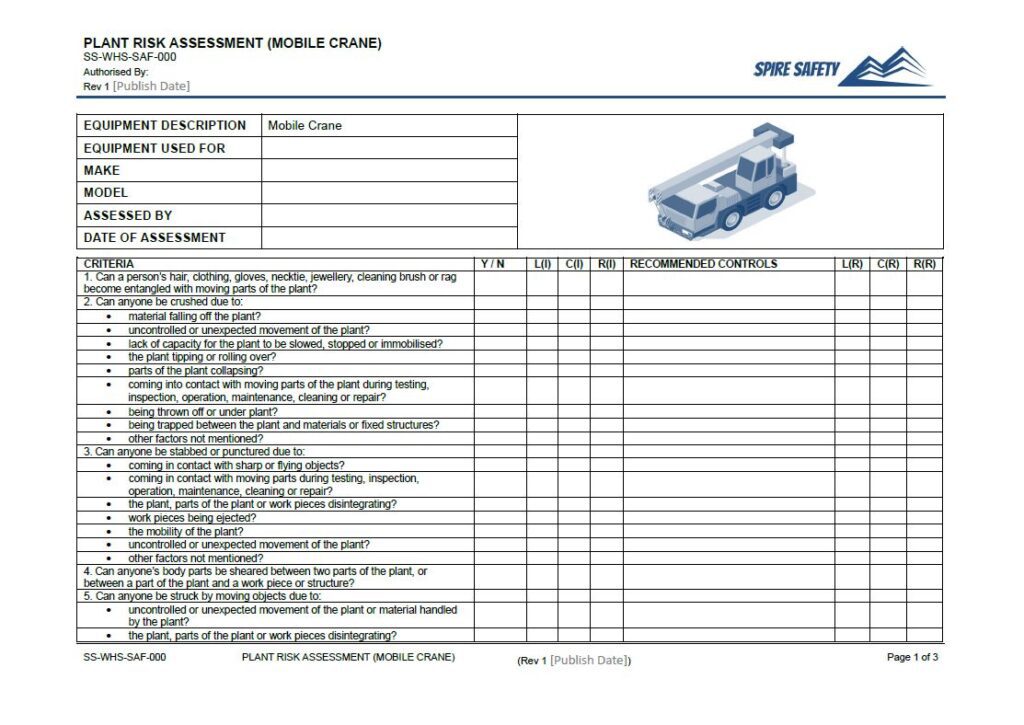Free Mobile Crane Risk Assessment Template
Download our free Mobile Crane Risk Assessment Template:
- Mobile Crane Risk Assessment Template .doc file (Word Document)
- Mobile Crane Risk Assessment Template .pdf file (PDF)
*For internal use only. Not for resale or redistribution. By downloading, you agree to our Free Resources Licensing Agreement.
 Purpose of Document
Purpose of Document
Mobile crane risk assessment templates are used to identify and assess the risks of mobile cranes. The primary goal is to protect workers from injury or illness through effective hazard identification and risk assessment processes. This form is broadly aligned with AS45001:2018.
How to Use
This plant risk assessment should be completed by a competent person in consultation with workers who use the plant.
This document is a template only and it must be customised for your business. Other aspects that may need to be considered include, but are not limited to, ensuring that:
- Relevant legal requirements have been met,
- Workplace specific risks are identified and managed, and
- Workers are consulted with during the customisation / review process.
When to Use
Plant risk assessments should be completed prior to the plant being used within your business.
Who Should Use
Plant risk assessments can be completed by your Safety Advisor, Project Manager or other competent person in your organisation. It should be completed in consultation with workers and other relevant personnel.
Legal Considerations
There is no specific legal requirement to complete a documented plant risk assessment. However, it is best practice, especially for larger companies. It can help meet general legal duties, including:
- s(19)(3)b WHS Act – Duty to Provide Safe Plant and Structures
- s(34) WHS Regulations – Duty to Identify Hazards
- s(203) WHS Regulations – Management of Risks to Health and Safety (PCBUs with management or control of plant)
The Code of Practice “Managing risks of plant in the workplace” also recommends the use of a documented hazard identification / risk assessment process.
Other laws may also be relevant for mobile cranes, including:
- s(81) Persons Must Hold HRWL of the Relevant Class
- s(85) Evidence of Licence (PCBU Must Sight HRWL)
Some states have state-specific laws or codes for mobile crane or crane use. For example QLD’s Mobile crane – Code of Practice 2006.
FAQ
What is plant?
Plant in the context of workplace safety refers to machinery, equipment, appliances, containers, implements, and tools, including their components or anything connected to them.
What is not plant?
Plant that relies exclusively on manual power for its operation and is designed to be primarily supported by hand, for example a screwdriver, is not covered by the WHS Regulations.
What hazards are involved in mobile crane use?
Many hazards exist in mobile crane operation, for example
- Suspended loads
- Overhead / electrical hazards
- Plant / people interaction
- Crush points
- Collisions with other plant
Do you need a license to operate mobile cranes?
You will likely need a high-risk license to operate a mobile crane (check with your state regulator for details).
Legally, you only require a license to operate “high-risk plant” (usually). For other types of plant or equipment, the level of training provided should be suitable considering “the nature of the work, the nature of the risks and the control measures required” – WHS regulations s(39). That is, for plant that poses no or minimal risks, there may be very little training required. As the risks of the plant increases, the requirement for training also increases.
Article Sources and Further Reading
- Model Code of Practice: Managing risks of plant in the workplace (Safe Work Australia) <https://www.safeworkaustralia.gov.au/doc/model-code-practice-managing-risks-plant-workplace>
- Plant and machinery (Safe Work Australia) <https://www.safeworkaustralia.gov.au/duties-tool/construction/hazards-information/plant-and-machinery>
- Guide to mobile cranes (Safe Work Australia) <https://www.safeworkaustralia.gov.au/doc/guide-mobile-cranes>

 Purpose of Document
Purpose of Document